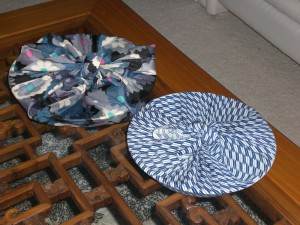
The Furoshiki is the traditional square Japanese wrapping cloth. The use of the word began during the Edo period and is made up of two words: Furo or ofuro, the Japanese bath and shiki or hiku, meaning to spread. When the Japanese went to the public baths they used the cloth to wrap their clothes, and that is how they came up with Furoshiki.
Today, the furoshiki is enjoying a bit of a revival because it is considered an environmentally friendly alternative to wrapping paper, that can be used over and over. You can give the furoshiki as a bonus gift, or many times in Japan, to protect the gift, the furoshiki is wrapped around the gift that is wrapped in paper. I guess that defeats the purpose of being environmentally friendly! Also, the fabrics come in such a variety of prints that it’s fun just to collect. In the photo I have two blue furoshiki; a traditional Japanese print and a modern floral print – I love them all! The Japanese have taken this simple square cloth and made wrapping into an art form.
How do you wrap? The easiest and most convenient way to tie a furoshiki is by simply laying the square fabric on a flat surface. Then place what you want to wrap in the center. Take the two opposite corners and tie a square knot. Then take the remaining corners and tie another square knot and you have a neatly wrapped item.
You can wrap anything in any shape or size. All you have to do is increase the size of the furoshiki. Here is an example of when you need a really large one. When growing up in Tokyo, I remember the ‘tamagoya-san’ or ‘egg-man’ as we named him, who used to go door to door to sell eggs, sometimes on his bicycle and other times by foot. When he came on foot, on his back was a large furoshiki carrying crates of raw eggs! I guess you can consider this the original backpack.
The furoshiki in my home has many uses. If I go to a potluck, I always wrap my dishes in a furoshiki because it is easy to carry and conforms to the shape of the plate. It is also useful as décor because of the beautiful designs. I use it as a table cloth, or an accent mat. In Japan, it’s commonly used to wrap their lunches or obento and can be tied into a simple bag.
In my youth as a dancer, my girlfriend Maki taught me how to use the smaller sized furoshiki to separate our dance gear in our bags; clean clothes in the furoshiki and the dirty, wet items would go straight in a plastic bag. It was a way to compartmentalize a large bag into little bags. Today, I still use this wonderful tip when traveling. I have shirts in one furoshiki, pants in another, clean underwear in another and so on; it makes identifying your items very easy. Please share your uses for the furoshiki!


